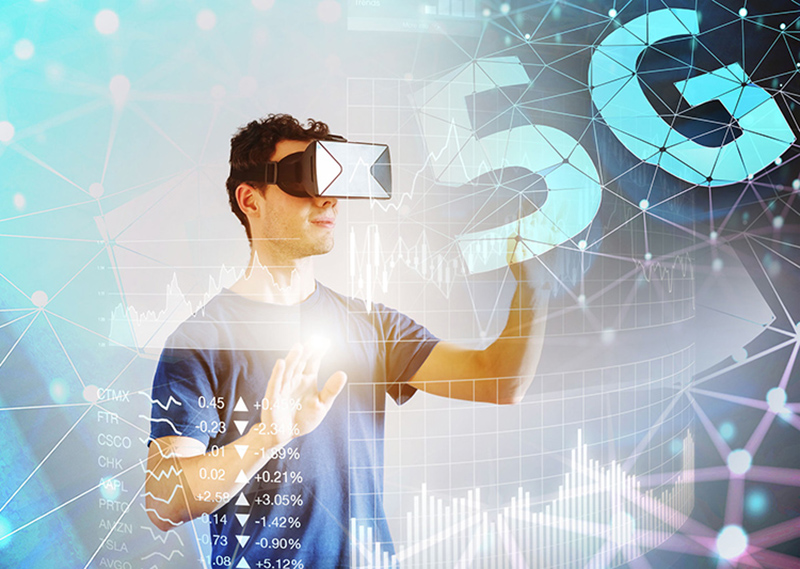
By Maria Lema and Mischa Dohler
Mobile Systems have become commodity and this article thus examines the timely question of what 5G can deliver in terms of extra value. We argue that, based on fundamental trends, some exciting technology transformations will happen with 5G. These will enable a new Internet, and the Internet of Skills.
Trends in Wireless Communications and Digital
Mobile communications has started as a niche technology but quickly evolved into a fully-functioning mobile Internet with global coverage. 4G is now so performant that consumers often forget about being connected wirelessly: the experience is virtually the same as when behind a desktop computer.
With 2G, 3G and 4G generations of mobile now deployed globally, the technology is starting to become commodity and is naturally experiencing market pressure underpinned by shrinking margins and higher deployment costs. It is hence timely to pose the question on the future of mobile, notably the role and value of 5G.
Technology disruption is tightly coupled to innovation. We thus examine required changes in the technology and innovation landscape to enable such a transformation. This in turn impacts finances, business models and value chains in mobile and digital at large.
These insights are constructed on solid observations of trends in mobile. Indeed, years of developments in wireless communications, deployment and usage allow us to draw the following two fundamental trends:1
[ms-protect-content id=”9932″]
First, there is the trend of “KPI Orders of Magnitude between Generations”: The key performance indicators (KPIs) of cellular have evolved in a rather consistent way from generation to generation. The most important ones are rate, number of devices and delay/latency; each of these has increased or decreased by 1-2 orders of magnitude. For instance, the rates evolved from 2G to 3G to 4G respectively from kbps to Mbps to Gbps.
5G and the evolutions thereafter are unlikely to follow a different trend. Notably, for 5G this means that rates will be tens of Gbps, the number of devices per base station 300,000 or more, and the latency in the range of 1-10ms. For the first time, these numbers overstep some fundamental thresholds which make 5G very interesting for stakeholders which traditionally were not associated with cellular technologies.
For instance, the extremely high number of devices (and optimised power consumption) allows 5G to enable the emerging Internet of Things (IoT) which requires billions of end-points to be connected. Given the global coverage (with mobility and roaming support), 5G is hence consolidating as a serious candidate to enable the IoT.
Another example relates to the very low latencies (along with low outages), which enables critical applications to be serviced. Given the ability to offer service level agreements (SLAs), 5G is hence also consolidating as a serious candidate to enable Industry 4.0 applications.
Second, there is the trend of “Contributors to Million-fold Capacity Increase”: Wireless capacity has approximately increased by a factor of one million over the past 35 years.2 The trend is based on Martin Cooper’s law which says that wireless capacity doubled every 30 months over past 100 years. The breakdown of these gains is 5x for new systems (e.g. 2G -> 3G -> 4G); 5x for various small factors; 25x due to spectrum; and a whooping 1600x due to reduced cell sizes (i.e. going from macro cells to micro cells).
The largest contributor to an increase in capacity is simply due to smaller cell sizes. The impact of all other factors remains surprisingly small: a new system contributed roughly with 0.3% to the capacity when compared to smaller cell sizes; whereas spectrum accounts for 1.5%. It is due to these smaller cell sizes that cellular has become much more heterogeneous with this trend to continue (if not accelerate with 5G and beyond).
Technical Transformations
First, we need a transformation from hard KPIs to the perception of KPIs: Smaller cell sizes and increasing traffic, will make it impossible to offer viable deployments which satisfy data rates, outage, delay, etc. Therefore, we advocate for a fundamental change in design approach where systems are not designed (and regulated) based on the measured KPI but on the perceived KPI.
Let us take the example of the rate.1 The majority of the capacity in a future 5G system will be provided via high capacity millimetre wave small cells. Providing ubiquitous radio frequency (RF) coverage is technically challenging and economically prohibitive. Instead, one ought to use predictive analytics on user data usage behaviour, user movement behaviour and speed, etc. That would allow one to buffer the to-be-watched Netflix/Youtube video until the next access point is reached. Several disruptions are needed here, with the most notable being that application layer needs to communicate with lower layers so as to execute the best strategy.
Second, the community requires a much atomised and decoupled architecture: The breakdown on the increase of wireless capacity over the past three decades, as discussed above, indicates that smaller cell sizes are the biggest contributor. This in turn translates to more heterogeneous architectures, which have to be managed in a novel way. The standards body 3GPP (which standardises mobile systems) has proposed to decouple control and data planes via phantom-cell approaches but we have found that decoupling the up- and downlinks allows for much higher throughputs and, above all, smaller outages.3 Continuing this trend, a challenge will be to design a completely decoupled architecture, i.e. decoupled in features and functionalities, and thereby enabling ultra-low latency and ultra-reliable communications.
A third and important required transformation is on the “thinning” of the Core Network infrastructure: Scalability in cellular systems is hugely limited by the physical infrastructure of the Core Network (CN). For instance, a typical operator in a country like the UK has only about a handful of gateways for the entire country. The CN is in fact an artefact of pre-Internet times as it was introduced in 2G because none of the operators believed that there will ever be a general Internet which is able to carry the voice traffic. 30 years on, we still use the CN and thereby greatly limit the scalability of the wireless edge, which – because of above discussions – limits the rates to be delivered. To be able to scale, we thus need a much smarter way of cross-utilising available fibre infrastructures so as to maximise the ability to transmit the mobile traffic. That would also help with reducing the end-to-end delays.
A fourth and interesting transformation is to use 5G-as-a-Control-System: The inspiration to this is because Wifi link capacity has always been 1-2 orders of magnitude higher than cellular link capacity, at any point in time. At the same time, it is well established that the ratio between control-to-data packet size is about 1-2 orders of magnitude in typical communications systems.
Based on this observation, we suggest exploring if combining the best of both worlds allows one to achieve prior unseen performance gains. Notably, one needs to research the architectural and protocol approach to have 5G act as a control channel/system for all wireless systems available globally. Going well beyond today’s license assisted access (LAA), cellular would be responsible to coordinate various Wifi and other systems to ensure best possible link performance whilst offering mobility/roaming as well as billing.
What is 5G?
5G departs from the design principles of prior generations. It is about time as few would argue that mobile experience is universally satisfactory. Whilst designing a system which works under complex mobility scenarios and is available globally is not an easy, the quality of experience with the (fibred) Internet has always been much better. And the reason may well be because we do not have Cisco, Microsoft and Facebook sit together for a decade to come up with a new Internet. Each is innovating independently as technologies are decoupled and only communicate via well-established interfaces.
Legacy telecoms systems were highly optimised but closed end-to-end system with limited scale. 5G will be fundamentally different, borrowing concepts from the Internet, i.e. there is a strong decoupling of hardware and software, and atomisation of software. That enables a transformation of the value chain in 5G and beyond, enabling advanced concepts like “telco-as-a-service”. In more details, which is also illustrated in Figure 1, 5G will be underpinned by two major transformations:
First, a decoupling of hardware from software, i.e. “softwarisation of the infrastructure”: By decoupling the hardware from software, each can innovate and scale on their own. This will allow one to use state of the art off-the-shelf hardware and provide all innovation in software which is much easier to scale and adapt. It also means that nations with strong software capabilities, such as the UK, can become global leader in 5G telecommunications systems.
Second, an atomisation of software and functionalities takes place: In legacy systems, the software code was often comprised of millions of lines of codes which were hard-coded into the hardware. This is about to change. 5G, as currently standardised by 3GPP, insists on a decoupling of functionalities. This means that they can be developed and implemented independently. It also allows the operators to package features at need, and virtualise them and thus place them where truly needed. For instance, if there is a novel way of doing authentication using distributed ledger technologies, one only needs to bind this in as a new code.
At King’s College London, we are involved in an exciting £16m project to develop the world’s first end-to-end 5G system operating over heterogeneous infrastructures. It includes very advanced software defined networking solutions which allow for dynamic interconnection of physical/virtual experimental resources across different sites. Users will be granted access to virtual slices of physical resources, thereby enabling multi-tenancy future 5G and internet experimentation on a massive scale.
King’s 5G capabilities are illustrated in Figure 2. They include 5G radio technology in the three pioneering spectrum bands (and based on Ericsson’s world-class 5G equipment, market’s best so far). It also includes an advanced and flexible functional-split cloud-RAN testbed; and a fixed/mobile convergence testbed. All that is managed using King’s in-house controller and orchestration framework, which is based on standardised approaches and is underpinned by advanced artificial intelligence (AI).
Towards a New Internet and Exciting Applications
Underpinned by above ultra-low latency and ultra-high bandwidth 5G system, current embodiments of the Internet will be dwarfed by the emergence of industrial local area networks (“Industry 4.0”) and – believed to be a true paradigm shift – by the Internet of Skills (“Human 4.0”)4.
By enabling the delivery of physical experiences remotely, the Internet of Skills will revolutionise operations and servicing capabilities for industries and it will revolutionise the way we teach, learn, and interact with our surroundings for consumers. The 5G-enabled Internet of Skills will thus be an enabler for remote skillset delivery and thereby democratise labour the same way as the Internet has democratised knowledge.
The potential global impact of this creation would be phenomenal and instrumental in conquering some of the world’s biggest challenges. The Internet of Skills – having reached widespread adoption or being deployed at needs – will enable important disaster operation applications such as remote monitoring/surgery of people in need (e.g. applicable in Ebola hit areas); it will enable remote education (e.g. a child in Gaza is taught painting); it will enable industrial remote decommissioning and servicing capabilities (e.g. the remote reparation of a broken car in Africa); among other important applications.
The powerful capabilities of 5G will enable other exciting applications, such as the emerging concept of Synchronised Reality,5 which is perceived to be an important step beyond Virtual/Augmented Reality. Here, the ultra-low latency yields the perception of immediacy and thus allows for much more immersive experiences.
First industry applications of 5G are also emerging where King’s College London, together with Ericsson, has pioneered some of the most exciting application use cases.6 These are in 5G-enabled health, performing arts, gaming, transport and many others.
5G will transform the telco business and technology ecosystem. It will be an enabler for Real-Time Immersion, Synchronised Reality and the Internet of Skills.
[/ms-protect-content]About the Authors
Dr. Maria A. Lema is leading the 5G UK Testbeds and Trials project at King’s College London, coordinating all technical activities for the deployment of the 5G testbed in London. Most of her research in this area has been focused on designing end to end utra-reliable low latency 5G networks in the context of the Internet of Skills.
 Mischa Dohler is full Professor in Wireless Communications at King’s College London, driving cross-disciplinary research and innovation in technology, sciences and arts. He is the Director of the Centre for Telecommunications Research, Co-Founder of the pioneering smart city company Worldsensing, Fellow of the IEEE, the Royal Academy of Engineering and the Royal Society of Arts (RSA), and a Distinguished Member of Harvard Square Leaders Excellence.
Mischa Dohler is full Professor in Wireless Communications at King’s College London, driving cross-disciplinary research and innovation in technology, sciences and arts. He is the Director of the Centre for Telecommunications Research, Co-Founder of the pioneering smart city company Worldsensing, Fellow of the IEEE, the Royal Academy of Engineering and the Royal Society of Arts (RSA), and a Distinguished Member of Harvard Square Leaders Excellence.
References
1. M. Dohler, T. Mahmoodi, M.A. Lema, M. Condoluci, F. Sardis, K. Antonakoglou, A.H. Aghvami, “Internet of Skills, where Robotics meets AI, 5G and the Tactile Internet”, EuCNC 2017, Oulu, Finland.
2. M Dohler, R.W. Heath Jr., A. Lozano, C. Papadias, R.A. Valenzuela, “Is the PHY Layer Dead?”, IEEE Communications Magazine, vol 49, issue 4, April 2011, pp 159-165.
3. M.A. Lema, E. Pardo, O. Galinina, S. Andreev, Mischa Dohler, “Flexible Dual-Connectivity Spectrum Aggregation for Decoupled Uplink and Downlink Access in 5G Heterogeneous Systems”, IEEE JSAC, in press.
4. M. Dohler, et al, “Internet of Skills, Where Robotics Meets AI, 5G and the Tactile Internet”, EuCNC 2017, Oulu, Finland.
5. The term “Synchronised Reality” was coined in a conversation between Samantha Hemingway (Hemingway Media) and Mischa Dohler whilst discussing the ultra-low latency 5G capabilities.
6. For a full exploration of all these 5G use cases, please, visit https://www.ericsson.com/en/networked-society/innovation/reliable-communications/kings-college.






























